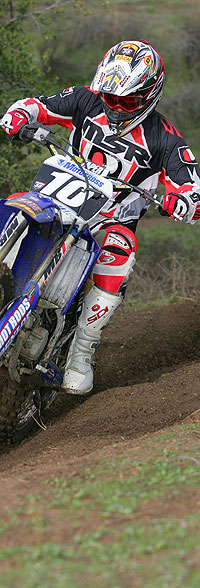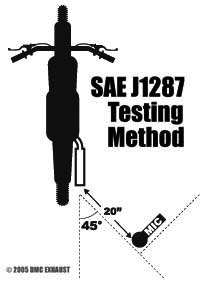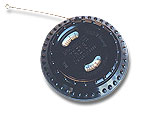Article: Sound Control Sound Control: Facts and Myths about Understanding the Sound Level Testing Method Sound Control: Facts and Myths about Understanding the Sound Level Testing MethodAnyone who rides knows that sound is an issue Whether you?re in the trails being drilled by Johnny Ranger or at the track being interrogated by officials like you were smuggling ferrets across the border, everyone eventually has a sound story. Between forestry regulations and AMA racing rules, there?s a lot of stories, mixed with truth and mixed with experiences from officials who don?t know what they?re doing ? leaving a lot of it in question. The truth is that sound performance is a critical component in any exhaust purchase. Now more than ever, strict regulations make it harder for exhaust companies to achieve maximum performance while meeting forestry or track compliance. In the state of California, off-road motorcycles are required to operate at 96db or less when tested with SAE J 1287 standards. This standard was developed by the Society of Automotive Engineers in a document titled ?Measurement of Exhaust Sound Levels of Stationary Motorcycles?. For $47, it may just be the cure for insomnia. Regardless, the facts remain. There has to be standards and a universal form of measuring sound and this is it. Although exhaust manufacturers do their best to comply with these guidelines, you often hear stories of this pipe passing and that pipe failing sound checks. Sound is a funny thing. It bounces off walls, rattles through corridors, becomes muffled under cloud cover, and varies in changing humidity conditions. Environment and atmospheric conditions can all affect the decibal level of an exhaust system. What test results you achieved in the morning may be completely different than the test results in the afternoon. Because the atmosphere doesn?t tend to reduce low frequency sound waves, 4-Stroke sound carries much farther than 2-Stroke Sound. Depending upon how your pipe is being inspected, where it?s being inspected, and whether the inspection is actually being done properly and if the equipment is properly calibrated, there will always be variables that produce different results. So with all these variables, SAE J1287 is written to allow a variation of +/- 1.5db. Now, it?s highly unlikely that most riders will have the proper equipment or experience to perform an accurate sound check, but knowing what to look for when it?s your time on the block could be beneficial. So, before the test begins, are you prepared? For starters, make sure you?re not testing inside your box van, in your truck bed or on a trailer. Reduce any other possible sound interference such as other engines running close by, cheering crowds, your mother screaming that you should have picked a safer hobby, etc.. Make sure your exhaust is not facing any close obstacles or structure which may amplify the sound waves or bounce them back to the measuring device. Are they using proper sound equipment? For better accuracy, it?s important the measuring device meets ANSI standards. Anything less cannot insure accurate readings. Is your bike already warm from a few laps or are you starting it cold for the sound check? Although you can?t always predict when you?re going to have to face the man, if you have the added benefit of knowing in advance, a cold or warm engine will give you the advantage. Fluids are thicker and somewhat more effective at reducing additional noise that could be picked up by the sound monitoring device. A hot engine can push the metering up by half a point.
So, it?s time for your test. SAE J1287 standards has specific guidelines for proper sound testing. Providing that ambient noise around you is under 10db and wind speed is under 20mph, they can proceed with the test. Following the diagram shown here, the microphone should be positioned in a straight line, 20? from the end of exhaust and angled at 45?. Also, the microphone must feature a wind sock (those foam covers) and be positioned at the same elevation as the tip of the exhaust (within 1" up or down). Lastly, there can?t be any objects or structures within 16? of the text bike and the tester. Once this is established, you?ll be instructed to gradually run the bike?s rpms to a specified limit. The rpm designation is a bike-specific number, meaning, your 2005 CRF450 will have a different RPM designation than a YZ250. (This information is prepared in advance and is available for anyone to view. For more info, visit the Motorcycle Industry Council website and download the Model Test RPM Data in a PDF http://www.mic.org)
So, with the tachometer in place, the sound testing equipment operational and properly positioned and lined up, you follow the rev procedure, you?re feeling good, but you fail the test anyway. Why? Take a look at some of the obvious to "not so" obvious factors that can impact your test. 
So the next time you?re under the spotlight with beads of sweat running down your face like an interrogation scene from a bad cop show, just remember these tips and tricks. Remember, Johnny Ranger and your track official are certified for sound inspection, so give them some respect during the testing. Watch your sound inspection carefully and if you think there?s an error in setup, monitoring, or results, kindly suggest to them what you know here. Some will be receptive to sharing procedural information. Others won?t. Either way ? knowledge is power. Ride safe. |
 Another tip for clearing sound checks has to do with tuning. Not only will your bike run better if properly tuned, but it will help you pass sound inspection. One of the biggest things you can do is maintain silencer packing. It?s not only good for sound control, but aids in keeping your silencer cooler and helps in delivering maximum power. Jetting, timing, and spark plugs all contribute to your bike?s performance in a sound check. Running a little rich can help keep the engine from sputtering, so it?s clear that attention to your bike?s overall performance can be a huge help.
Another tip for clearing sound checks has to do with tuning. Not only will your bike run better if properly tuned, but it will help you pass sound inspection. One of the biggest things you can do is maintain silencer packing. It?s not only good for sound control, but aids in keeping your silencer cooler and helps in delivering maximum power. Jetting, timing, and spark plugs all contribute to your bike?s performance in a sound check. Running a little rich can help keep the engine from sputtering, so it?s clear that attention to your bike?s overall performance can be a huge help. A tachometer is also used in the sound test to verify rpm?s. There?s a couple techniques that officials use, but surprisingly, one of the most common is a $25 Briggs and Stratton Vibratach. It?s a simple little device about the size of a hockey puck and thinner. There seems to be a couple ways to use it, but the most common method is to lay the Vibratach on the rear fender where it can measure cyclical vibrations to determine rpms with incredible accuracy.
A tachometer is also used in the sound test to verify rpm?s. There?s a couple techniques that officials use, but surprisingly, one of the most common is a $25 Briggs and Stratton Vibratach. It?s a simple little device about the size of a hockey puck and thinner. There seems to be a couple ways to use it, but the most common method is to lay the Vibratach on the rear fender where it can measure cyclical vibrations to determine rpms with incredible accuracy.